
| WWT Shows | CLICK TO: Join and Support Internet Horology Club 185™ | IHC185™ Forums |

|
• Check Out Our... • • TWO Book Offer! • |
Welcome Aboard IHC185™  Internet Horology Club 185
Internet Horology Club 185  IHC185™ Discussion Site Main Page
IHC185™ Discussion Site Main Page  Horological Discussions, Questions and Answers
Horological Discussions, Questions and Answers  European Pocket Watch Forum
European Pocket Watch Forum  What is it-No serial number/No name
What is it-No serial number/No name
 Internet Horology Club 185
Internet Horology Club 185  IHC185™ Discussion Site Main Page
IHC185™ Discussion Site Main Page  Horological Discussions, Questions and Answers
Horological Discussions, Questions and Answers  European Pocket Watch Forum
European Pocket Watch Forum  What is it-No serial number/No name
What is it-No serial number/No nameGo  | New Topic  | Find-Or-Search  | Notify  | Tools  | Reply to Post  |  |
This is another watch thats kind of been rattling around in a box of watches for years, probably from my wife's family. Key wind/set OF-and someone told me "possible 9K gold case with gold filled chain and key. Check it out- Jim Hathaway NAWCC #159457 IHC Member #285 hathaway5522@earthlink.net | |||
|
Check it out-- Jim Hathaway NAWCC #159457 IHC Member #285 hathaway5522@earthlink.net 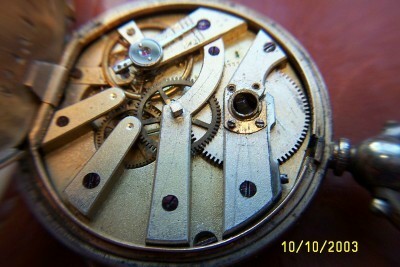 | ||||
|
next Jim Hathaway NAWCC #159457 IHC Member #285 hathaway5522@earthlink.net | ||||
|
| Watch Repair Expert |
Your watch is a "generic" Swiss product of the mid 19th century. The movement design is what's generally called a "bar movement," and it appears to have a cylinder escapement, which were common among movements of that type. Unfortunately, you'll probably never be able to ascertain the exact age or the true manufacturer, and even if you did, it would be purely academic. Watches of that type were so common and so "anonymous," that few collectors have any real interest in them. ==================== Steve Maddox President, NAWCC Chapter #62 North Little Rock, Arkansas IHC Charter Member 49 | |||
|
I would just like to add that not all Swiss bar movements are uninteresting. This style of movement, known as a Lepine caliber, was designed by Jean-Antoine Lepine in the late 17th century to make a much thinner watch than had been made before (full-plate watches). The style was modified and used by mass manufacturers and master craftsmen. The attached picture shows three examples and some of the variety in these movements. In the upper left is a fairly common looking example, similar to much of the mass-produced nameless variety. The movement in the upper right was made by Vacheron & Constantin, and is quite similar (except for the lever escapement) to the subject watch of this thread. I suspect (from observation) that the more radial layout of the bridges, such as the lower example and the V&C, may be an earlier form. 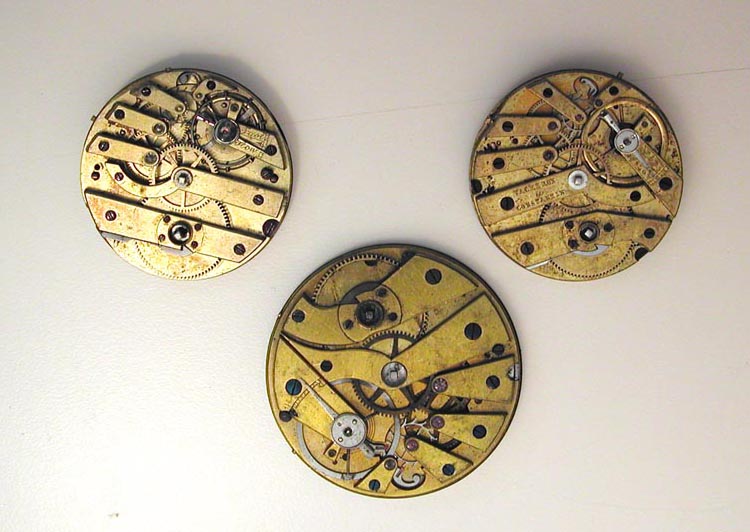 | ||||
|
Here are two other interesting examples of anonymous Swiss keywind movements. The bridges are so stout that I am not sure if "bar movement" really applies to the one on the left. What make these interesting is the inclusion of features like the "parachute" device on the upper balance jewelling for shock protection (invented by Breguet) and the bimetallic curb for temperature compensation. If you look carefully through the countless bar movements you see in accumulations of watch "junk" you may be pleased with what you can find. Are they worth anything? My examples probably have very little monetary value, but look at what you can have examples of for a pittance!  | ||||
|
Here is a close-up -- 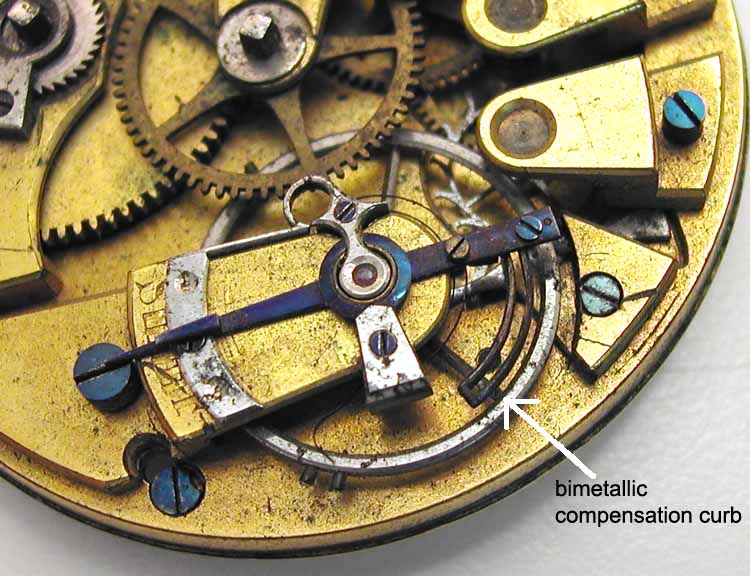 | ||||
|
| Watch Repair Expert |
There's a small difference between a "bar movement" and a "L'Epine" style movement (although the French consider the term "L'Epine" or "LePine" to simply mean "open face"). More specifically, perhaps it could best be said that a "bar movement" is a specific type of "L'Epine" style. L'Epine style movements are often characterized by a somewhat "radial" pattern of bridges and cocks, and in most instances, the cocks are triangular in form, with offset bases so that countersunk holes for the screws are not necessary. They also frequently have "free standing" spring barrels, with stopworks on top. Typical "bar movements," however, are distinguished by a pattern of bridges and cocks that are arranged in generally parallel lines, and are composed of "bars" with essentially parallel sides. In most "bar movements," the screw heads are countersunk, and the tops of all the bridges and cocks occupy a single plane. To me, the watch in the upper left corner of Jerry T's first image above, is a classic "bar movement," while that on the left in the next image (and above this reply) is a classic "L'Epine" style. The others share some characteristics of each, and I wouldn't presume to "split hairs" about which style a particular person might choose to call them, but I'd call the V&C a "bar movement," and the one below it a "L'Epine." By the way, Jerry, that's an interesting "Sublet." I like that! ==================== SM Steve Maddox President, NAWCC Chapter #62 North Little Rock, Arkansas IHC Charter Member 49 | |||
|
Look Jim Hathaway NAWCC #159457 IHC Member #285 hathaway5522@earthlink.net 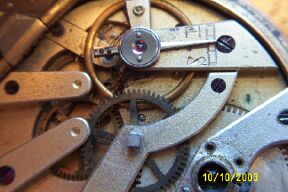 | ||||
|
next Jim Hathaway NAWCC #159457 IHC Member #285 hathaway5522@earthlink.net  | ||||
|
More Jim Hathaway NAWCC #159457 IHC Member #285 hathaway5522@earthlink.net 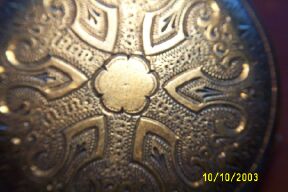 | ||||
|
More Jim Hathaway NAWCC #159457 IHC Member #285 hathaway5522@earthlink.net  | ||||
|
More pix Jim Hathaway NAWCC #159457 IHC Member #285 hathaway5522@earthlink.net 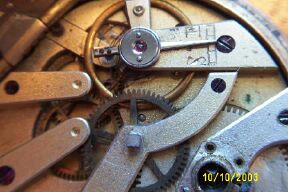 | ||||
|
Thanks for input. Did not know anything about it. Jim Hathaway NAWCC #159457 IHC Member #285 hathaway5522@earthlink.net | ||||
|
| Powered by Social Strata |
| Your request is being processed... |
|
Welcome Aboard IHC185™  Internet Horology Club 185
Internet Horology Club 185  IHC185™ Discussion Site Main Page
IHC185™ Discussion Site Main Page  Horological Discussions, Questions and Answers
Horological Discussions, Questions and Answers  European Pocket Watch Forum
European Pocket Watch Forum  What is it-No serial number/No name
What is it-No serial number/No name
 Internet Horology Club 185
Internet Horology Club 185  IHC185™ Discussion Site Main Page
IHC185™ Discussion Site Main Page  Horological Discussions, Questions and Answers
Horological Discussions, Questions and Answers  European Pocket Watch Forum
European Pocket Watch Forum  What is it-No serial number/No name
What is it-No serial number/No name©2002-2025 Internet Horology Club 185™ - Lindell V. Riddle President - All Rights Reserved Worldwide

